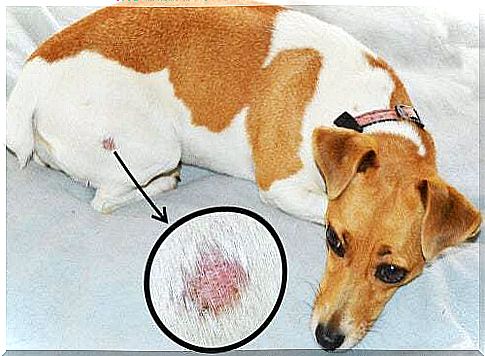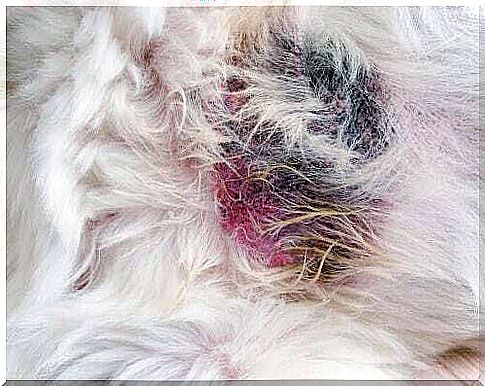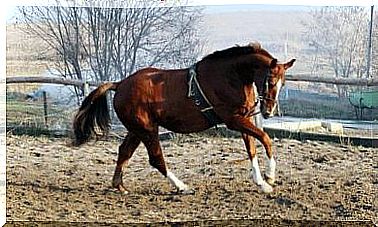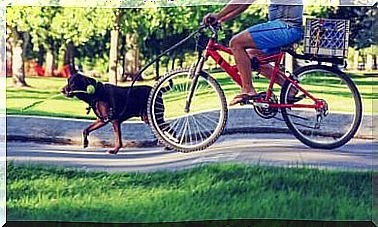Ringworm In Puppies: Symptoms And Treatment

Ringworm in puppies is a fairly common condition. This is because dogs have not yet developed their immune defense skills at an early age. Likewise, dogs that are malnourished or suffering from a serious disease – which undermines their defenses – are more susceptible to disease. Among these, one of the most common is ringworm.
This disease is a zoonosis, that is, it can be transmitted to humans. It presents with a crusty, itchy rash. In humans, ringworm manifests itself as a circular sore on the skin.
In this article we will talk about ringworm in puppies , as well as the symptoms and treatment for this disease.
What is ringworm?
Ringworm results from an infection caused by a fungal parasite (dermatophyte) that affects the skin of pets and people. This parasite feeds on keratin, a family of proteins that make up the structure of hair, nails and the outer layer of the skin.
There are many types of dermatophytes, but most cases of canine ringworm are caused by fungi of the genus Microsporum , Trichophyton, and Epidermophyton . The most common species in this type of canine infection is Microsporum canis .
Ringworm has also been linked to microsporum gypseum infection . In this case, the fungus is carried by rodents. Pups can become infected by digging the soil in spaces where there are rodent burrows.
As mentioned above, ringworm easily spreads to humans. Particularly sensitive are very young children, the elderly or anyone with weak immune systems. We are talking about ringworm in puppies: symptoms and treatment.
Symptoms of ringworm in puppies
In this infection the degree of itching and the appearance of the lesions can vary from case to case. The manifestation of the disease will vary according to the virulence and degree of adaptation that the infectious species presents.
The dermatophyte lives only in actively growing hairs. Infected hairs peel off and fall out of the skin. The dog may also develop crusted sores that can be both mild and severe.
Usually, the lesions present with areas where hair is missing or with total loss of hair in areas with a circular shape. These hairless spots have a scaly surface, they can appear gray or reddish.

In general, ringworm lesions appear on the paws, head and ears of dogs, but they can spread to any part of the body. It is important to note that puppies suffering from ringworm infection will not necessarily show this distinctive pattern.
The sores can expand even without having a ring shape and can be viewed as a variety of other diseases, such as skin allergies.
Transmission of ringworm in puppies
Ringworm is transmitted through direct contact with the scales of the skin or hair (including hair) of infected people or animals. The fungus produces infectious “seeds” called spores, which are quite resistant and difficult to remove from the environment and can live for years.
However, only broken skin cannot be infected – a dog with healthy skin will not have a ringworm infection. The incubation period is not well known, but some scholars say it is between two and four weeks. If the animal has a weak immune system this period is shorter.
Some apparently healthy pets – without showing any symptoms – can become carriers of the infection. This means that they can transmit the infection to other animals. Once a pet becomes infected, the spores pollute the environment and can remain for months.
Ringworm is transmitted by direct contact, but it can also be transmitted through contaminated hygienic equipment.
Ringworm: diagnosis
Ringworm should never be diagnosed on the basis of the lesions that the individual has. This bad habit leads to misdiagnosis and unnecessary exposure to an anti-fungal treatment which can be toxic to the puppy.
On the other hand, if the infection is diagnosed in only one pet, they should all undergo treatment, whether they show signs or not. Ideally, infected pets should be quarantined from those that show no signs of disease.

If you think your dog has ringworm, you should take him to the vet, as he will need an accurate diagnosis and proper treatment. Only then will you be able to cure and prevent the fungus from spreading to people and other pets in your family.
Early diagnosis makes it possible that the treatment to be applied is less aggressive and reduces the possibility of infection. Occasionally, it may be sufficient to strengthen the immune system of the affected animal.
Usually, treatment consists of applying a topical fungicide in the form of an ointment, powder, or lotion to the entire body of the affected animal. Only in more advanced and severe cases is a systemic antifungal used.
It is important that when there is a suspicion of ringworm in puppies, you take them to the vet for advice and proper care. In addition, cleaning the home environment to eliminate spores requires expert advice.









